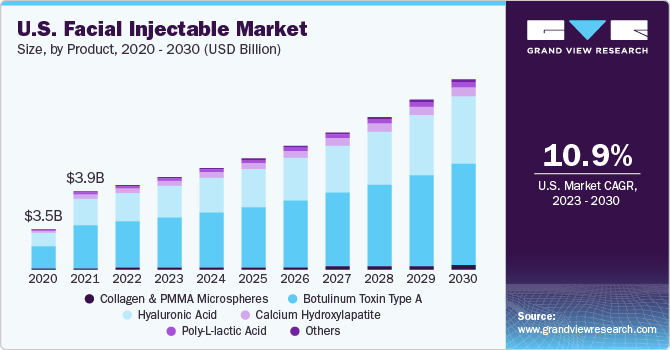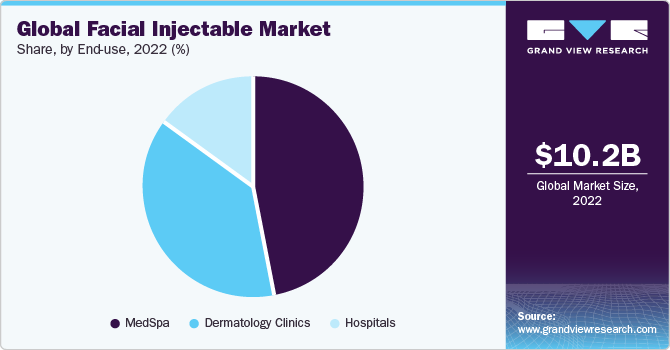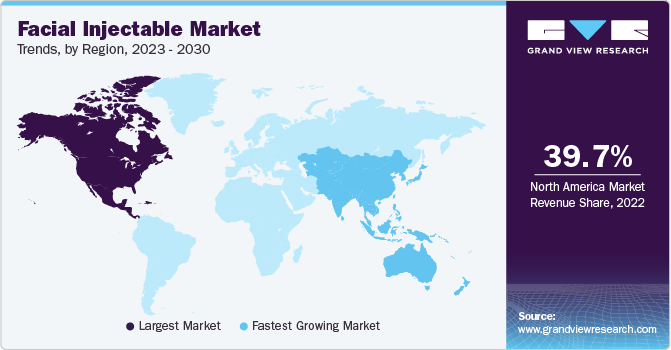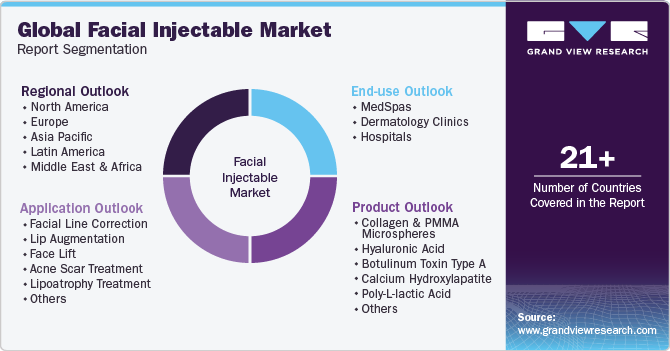- Home
- »
- Medical Devices
- »
-
Facial Injectable Market Size, Share & Trends Report, 2030GVR Report cover
![Facial Injectable Market Size, Share & Trends Report]()
Facial Injectable Market Size, Share & Trends Analysis Report By Product (Collagen & PMMA Microspheres, Hyaluronic Acid), By Application (Facial Line Correction, Face Lift), By End-use, By Region, And Segment Forecasts, 2023 - 2030
- Report ID: GVR-1-68038-849-7
- Number of Report Pages: 172
- Format: PDF, Horizon Databook
- Historical Range: 2018 - 2021
- Forecast Period: 2023 - 2030
- Industry: Healthcare
Facial Injectable Market Size & Trends
The global facial injectable market size was estimated at USD 10.22 billion in 2022 and is expected to grow at a compound annual growth rate (CAGR) of 12.0% from 2023 to 2030. A growing focus on physical appearance among consumers has led to an increased demand for facial injectables in recent years. The presence of a large population susceptible to various signs of aging has also boosted the demand for facial injectable medicine globally. Signs of aging, including wrinkles and sagging of the skin due to low facial elasticity, dark spots, and others, start appearing between 25 and 30 years of age and become more prominent from 30 to 65 years of age. Increasing awareness regarding minimally invasive procedures due to various beauty campaigns being organized by key players in the market is also a driving factor for market growth.

Minimally invasive surgeries are rapidly replacing invasive surgeries. For instance, according to the American Society of Plastic Surgeons (ASPS), in the U.S., nearly 18 million minimally invasive and surgical cosmetic products were performed in 2020, out of which nearly 16 million products were minimally invasive. Thus, the increasing adoption of minimally invasive surgeries, coupled with the availability of a wide range of such treatment options, is driving market growth.
The presence of well-established key players such as Allergan, Sinclair Pharma, and Galderma with a comprehensive injectable fillers portfolio treating a broad range of skin indications such as wrinkles, pigmentation, plumping of lips, scars, restoring facial fullness as well as enhancing facial contours is expected to drive the demand for facial injectable procedures thereby boosting market revenue. Increasing social media exposure, rising effectiveness, and approvals for facial injectables as well as the escalating desire among the population to look aesthetically appealing and young is expected to drive the market during the forecast period.
According to the International Society of Aesthetic Plastic Surgery (ISAPS), the U.S. was ranked 1st in terms of non-surgical products performed at a global level. Of these, injectables such as botulinum toxin and hyaluronic acid were among the most popular products performed. The country is backed by advanced treatment options and has the highest number of surgeons globally, with over 7,000 plastic surgeons as of 2019. These factors support market growth.
In June 2020, Allergan Aesthetics, a subsidiary of AbbVie Inc. (U.S.), received FDA approval for JUVÉDERM VOLUMA XC for the augmentation of the chin region in adults over the age of 21. Apart from this, in 2019, the FDA approved, Jeuveau which is similar to Botox, but available at a lower cost compared to Botox. The product is found to be effective in reducing wrinkles.
The aesthetic industry witnessed a significant setback due to the COVID-19 pandemic in the initial quarters of 2020. There was a drop in the revenue of the manufacturers due to supply chain disruptions. However, the survey conducted by Cynosure in June 2020 reported that the majority of the surveyed population showed a high willingness to opt for in-office non-invasive treatments. Even during the pandemic Botox and soft tissue fillers remained the most popular minimally invasive procedures in the U.S.
Product Insights
Based on product, the botulinum toxin segment dominated the marketand accounted for the largest revenue share of 53.0% in 2022. Middle-aged women are increasingly opting for fillers and injectables including the popular, Botox to reverse the signs of aging. The Hyaluronic Acid (HA) segment is projected to witness the fastest CAGR of 12.3% during the forecast period. It is known for its ability to store moisture in the skin, thus making the skin look healthier. HA has a moisture-binding characteristic that helps enhance and maintain the vital moisture responsible for the plumpness of the facial skin.
The cosmetic-grade HA has a low molecular weight that facilitates deep penetration of the product in the epidermis, which further helps retain water in the cells and releases antioxidants that delay the aging process. According to the International Society of Aesthetic, around 4,053,016 procedures for hyaluronic dermal injections were performed globally in 2020.
Application Insights
Based on application, the facial line correction segment dominated the market and accounted for the largest revenue share of 33.1% in 2022. Facial line correction is a significant application within the facial injectables market, catering to the preferences of individuals seeking nonsurgical cosmetic enhancements. This growth is owing to the increasing use of facial injectables for aesthetic procedures such as facial lines, wrinkles on the face, and lip lines. Factors such as growing awareness about aesthetic procedures and rising disposable income are expected to boost market growth. An increase in the use of facial injectables for parentheses lines, wrinkles on the face, lip lines, lip augmentation, lip border restoration, perioral lines, and crow’s feet lines is expected to assist in market growth.
The growing interest in physical appearance along with an increase in disposable income among the middle-class population in developing countries such as India is expected to boost demand for facial injectables for aesthetic purposes in the coming years.
End-use Insights
Based on end-use, the medSpa segment dominated the market and accounted for the largest revenue share of 46.8% in 2022. It is anticipated to continue its dominance with a CAGR of 12.2% over the forecast period. Medspa is a facility where cosmetic services are provided under the supervision of a licensed physician. All non-invasive treatments are performed in these facilities, which includes facial injections, non-invasive body contouring, skin rejuvenation, and laser treatments by experienced professionals.
These facilities follow all the regulatory policies and standards set by the government and have to be mandatorily owned by a physician. MedSpas are increasingly adopting novel treatment systems to gain a higher market share. The employees in medspas need to have a license in aesthetics as well as medical education.

Regional Insights
North America dominated the market and accounted for the largest revenue share of 39.7% in 2022. This growth is owing to the large geriatric population in the U.S. and Canada and is anticipated to propel the demand for facial injectables over the forecast period. According to the American Society of Plastic Surgeons (ASPS), the growth in rates of cosmetic surgery products from the year 2000 to 2018 was compared. It was observed that the use of Botox injections increased by 845%. Thus, North America is expected to be a key revenue generator for facial injectables in the coming years.

In the Asia Pacific, the market is projected to witness the highest CAGR of 15.7% during the forecast period. The region is backed by countries such as India, Australia, and South Korea. Growing awareness of the physical appearance in these developing countries is expected to play a key role in the demand for facial injectable treatment. India is projected to be the fastest-growing during the forecast period.
Key Companies & Market Share Insights
The key players are focusing on growth strategies, such as enhancements in existing technologies, geographical expansion, product launches, and product approvals. Recently, in February 2020, Sinclair Pharma offered distribution partnership rights of Sculptra (poly-I-Iatic acid injectable) to Galderma SA specifically in Europe.
In 2019, Allergan launched a TV ad campaign for its brand, Botox Cosmetics for millennials. According to the American Academy of Facial Plastic and Reconstructive Surgery, in the past five years, Botox injections have increased by 22% among 22- to 37-year-olds, focusing on which product is being launched by the company.
Key Facial Injectable Companies:
- Ispen
- Abbvie
- Medytox Inc.
- Merz GmbH and Co. KGaA
- Revance Therapeutics, Inc.
- Galderma
- Sinclair Pharma
Facial Injectable Market Report Scope
Report Attribute
Details
Market size value in 2023
USD 11.30 billion
Revenue forecast in 2030
USD 24.92 billion
Growth rate
CAGR of 12.0% from 2023 to 2030
Base year for estimation
2022
Historical data
2018 - 2021
Forecast period
2023 - 2030
Report updated
November 2023
Quantitative units
Revenue in USD billion and CAGR from 2023 to 2030
Report coverage
Revenue forecast, company ranking, competitive landscape, growth factors, and trends
Segments covered
Product, application, end-use, region
Regional scope
North America; Europe; Asia Pacific; Latin America; MEA
Country scope
U.S.; Canada; Germany; UK; France; Italy; Spain; Norway; Denmark; Sweden; China; Japan; India; Australia; Thailand; South Korea; Brazil; Mexico; Argentina; South Africa; Saudi Arabia; UAE; Kuwait
Key companies profiled
Ispen; Abbvie; Medytox Inc.; Merz GmbH and Co.; KGaA; Revance Therapeutics, Inc.; Galderma; Sinclair Pharma
Customization scope
Free report customization (equivalent up to 8 analyst's working days) with purchase. Addition or alteration to country, regional & segment scope.
Pricing and purchase options
Avail customized purchase options to meet your exact research needs. Explore purchase options
Global Facial Injectable Market Report Segmentation
This report forecasts revenue growth at global, regional, and country levels and provides an analysis of the latest industry trends in each of the sub-segments from 2018 to 2030. For this study, Grand View Research has segmented the global facial injectable market report based on product, application, end-use, and region:

-
Product Outlook (Revenue, USD Billion, 2018 - 2030)
-
Collagen & PMMA Microspheres
-
Hyaluronic Acid (HA)
-
Botulinum Toxin Type A
-
Calcium Hydroxylapatite (CaHA)
-
Poly-L-lactic Acid (PLLA)
-
Others
-
-
Application Outlook (Revenue, USD Billion, 2018 - 2030)
-
Facial Line Correction
-
Lip Augmentation
-
Face Lift
-
Acne Scar Treatment
-
Lipoatrophy Treatment
-
Others
-
-
End-use Outlook (Revenue, USD Billion, 2018 - 2030)
-
MedSpas
-
Dermatology Clinics
-
Hospitals
-
-
Regional Outlook (Revenue, USD Billion, 2018 - 2030)
-
North America
-
U.S.
-
Canada
-
-
Europe
-
UK
-
Germany
-
France
-
Italy
-
Spain
-
Denmark
-
Sweden
-
Norway
-
-
Asia Pacific
-
Japan
-
China
-
India
-
Australia
-
Thailand
-
South Korea
-
-
Latin America
-
Brazil
-
Mexico
-
Argentina
-
-
Middle East & Africa
-
South Africa
-
Saudi Arabia
-
UAE
-
Kuwait
-
-
Frequently Asked Questions About This Report
b. The global facial injectable market size was estimated at USD 10.22 billion in 2022 and is expected to reach USD 11.30 billion in 2023.
b. The global facial injectable market is expected to grow at a compound annual growth rate of 12.0% from 2023 to 2030 to reach USD 24.92 billion by 2030.
b. North America dominated the facial injectable market with a share of 39.7% in 2022. This is attributable to increased spending on aesthetic procedures and the easy availability of the products.
b. Some of the major players included in the facial injectable market are ALLERGAN; Ipsen; Merz Pharma; Suneva Medical, Inc.; Medytox, Inc.; Sinclair Pharma; Bloomage BioTechnology Corporation Limited; Anika Therapeutics, Inc.; Prollenium Medical Technologies Inc.; and Galderma S.A.
b. Factors like rising consciousness about external appearance among young and old individuals and rising awareness regarding the availability of various products and procedures, attributed to increasing globalization and social media influence are projected to further fuel the facial injectable market growth.
Share this report with your colleague or friend.
![gvr icn]()
NEED A CUSTOM REPORT?
We can customize every report - free of charge - including purchasing stand-alone sections or country-level reports, as well as offer affordable discounts for start-ups & universities. Contact us now
![Certified Icon]()
We are GDPR and CCPA compliant! Your transaction & personal information is safe and secure. For more details, please read our privacy policy.
We are committed towards customer satisfaction, and quality service.
"The quality of research they have done for us has been excellent."





